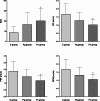Oral infection with periodontal pathogens induced chronic obstructive pulmonary disease-like lung changes in mice
- PMID: 39061018
- PMCID: PMC11282791
- DOI: 10.1186/s12903-024-04635-6
Oral infection with periodontal pathogens induced chronic obstructive pulmonary disease-like lung changes in mice
Abstract
Background: Epidemiological studies have demonstrated that periodontitis is an independent risk factor for chronic obstructive pulmonary disease (COPD). However, the mechanism underlying the association between these two diseases remains unclear. The lung microbiota shares similarities with the oral microbiota, and there is growing evidence to suggest that the lung microbiome could play a role in the pathogenesis of COPD. This study aimed to investigate whether periodontal pathogens could contribute to the pathogenesis of COPD in a mouse model.
Methods: We established mouse models with oral infection by typical periodontal pathogens, porphyromonas gingivalis (Pg group) or fusobacterium nucleatum (Fn group), over a three-month period. Mice that did not receive oral infection were set as the control group (C group). We assessed the level of alveolar bone resorption, lung function, and histological changes in the lungs of the mice. Additionally, we measured the levels of inflammatory factors and tissue damage associated factors in the lung tissues.
Results: Lung function indices, including airway resistance, peak inspiratory/expiratory flow and expiratory flow-50%, were significantly reduced in the Fn group compared to the C group. Additionally, histological examination revealed an increased number of inflammatory cells and bullae formation in the lung tissue sections of the Fn group. Meanwhile, levels of inflammatory factors such as IL-1β, IL-6, IFN-γ, and TNF-α, as well as tissue damage associated factors like matrix metalloproteinase-8 and neutrophil elastase, were significantly elevated in the lung tissue of the Fn group in comparison to the C group. The Pg group also showed similar but milder lung changes compared to the Fn group. Pg or Fn could be detected in the lungs of both oral infected groups.
Conclusion: The results indicated that oral periodontal pathogens infection could induce COPD-like lung changes in mice, and they may play a biological role in the association between periodontitis and COPD.
Keywords: Fusobacterium nucleatum; Porphyromonas gingivalis; Chronic obstructive pulmonary disease; Inflammation; Periodontitis.
© 2024. The Author(s).
Conflict of interest statement
The authors declare no competing interests.
Figures







Similar articles
-
Mouse model of experimental periodontitis induced by Porphyromonas gingivalis/Fusobacterium nucleatum infection: bone loss and host response.J Clin Periodontol. 2009 May;36(5):406-10. doi: 10.1111/j.1600-051X.2009.01393.x. J Clin Periodontol. 2009. PMID: 19419440
-
Porphyromonas gingivalis Capsule-Mediated Coaggregation as a Virulence Factor in Mixed Infection With Fusobacterium nucleatum.J Periodontol. 2017 May;88(5):502-510. doi: 10.1902/jop.2016.160397. Epub 2016 Nov 25. J Periodontol. 2017. PMID: 27885964
-
Long-term evaluation of oral gavage with periodontopathogens or ligature induction of experimental periodontal disease in mice.Clin Oral Investig. 2016 Jul;20(6):1203-16. doi: 10.1007/s00784-015-1607-0. Epub 2015 Sep 28. Clin Oral Investig. 2016. PMID: 26411857
-
Immunological Pathways Triggered by Porphyromonas gingivalis and Fusobacterium nucleatum: Therapeutic Possibilities?Mediators Inflamm. 2019 Jun 24;2019:7241312. doi: 10.1155/2019/7241312. eCollection 2019. Mediators Inflamm. 2019. PMID: 31341421 Free PMC article. Review.
-
About a Possible Impact of Endodontic Infections by Fusobacterium nucleatum or Porphyromonas gingivalis on Oral Carcinogenesis: A Literature Overview.Int J Mol Sci. 2024 May 7;25(10):5083. doi: 10.3390/ijms25105083. Int J Mol Sci. 2024. PMID: 38791123 Free PMC article. Review.
Cited by
-
Porphyromonas gingivalis inducing autophagy-related biological dysfunction in alveolar epithelial cells: an in vitro study.BMC Oral Health. 2024 Dec 5;24(1):1478. doi: 10.1186/s12903-024-05253-y. BMC Oral Health. 2024. PMID: 39639253 Free PMC article.
-
Connection between oral health and chronic diseases.MedComm (2020). 2025 Jan 14;6(1):e70052. doi: 10.1002/mco2.70052. eCollection 2025 Jan. MedComm (2020). 2025. PMID: 39811802 Free PMC article. Review.
-
Oral microbiota shifts following tooth loss affect gut health.BMC Oral Health. 2025 Feb 10;25(1):213. doi: 10.1186/s12903-025-05581-7. BMC Oral Health. 2025. PMID: 39930446 Free PMC article.
-
Periodontal Inflammation as a Modifiable Risk Factor for COPD Exacerbations in the Indian Population: A Prospective Cohort Study.J Pharm Bioallied Sci. 2024 Dec;16(Suppl 4):S4006-S4009. doi: 10.4103/jpbs.jpbs_1223_24. Epub 2024 Dec 27. J Pharm Bioallied Sci. 2024. PMID: 39926746 Free PMC article.
-
The protective role of muscone in the development of COPD.Front Immunol. 2025 Feb 17;16:1508879. doi: 10.3389/fimmu.2025.1508879. eCollection 2025. Front Immunol. 2025. PMID: 40034710 Free PMC article.
References
MeSH terms
Grants and funding
LinkOut - more resources
Full Text Sources
Medical
Miscellaneous

